It looks like you're using an Ad Blocker.
Please white-list or disable AboveTopSecret.com in your ad-blocking tool.
Thank you.
Some features of ATS will be disabled while you continue to use an ad-blocker.
share:
reply to post by SayonaraJupiter
I have no problem understanding that NASA didn't provide equipment capable of photographing stars
I wonder why you think it is suspicious tho. It seems likely to me that stars are better photographed using massive telescopes on earth, and photos from Apollo would not add anything new or useful.
Given the strict payload limits for the missions there would need to be good reasons for carrying the equipment.
I have no problem understanding that NASA didn't provide equipment capable of photographing stars
I wonder why you think it is suspicious tho. It seems likely to me that stars are better photographed using massive telescopes on earth, and photos from Apollo would not add anything new or useful.
Given the strict payload limits for the missions there would need to be good reasons for carrying the equipment.
reply to post by SayonaraJupiter
And just what does this have to do with proving any kind of hoax concerning so called faked pictures? After all, the main focus of the trip was the moon, not the stars. As Aloysius the Gaul put it we have better means to photograph the stars from the earth than what could have been carried by any space flight due to weight restrictions.
Photographing star fields from space, or a double-umbra on the far-side of the moon, during any Apollo mission shouldn't be difficult, how many trips did they make? How many orbits? Does the CMP see the doubler-umbra and star fields on every orbit? Of course he does!
And just what does this have to do with proving any kind of hoax concerning so called faked pictures? After all, the main focus of the trip was the moon, not the stars. As Aloysius the Gaul put it we have better means to photograph the stars from the earth than what could have been carried by any space flight due to weight restrictions.
edit on 11/18/2011 by Gibborium because: grammar
reply to post by Gibborium
However, Apollo 8 didn't have a lunar module on the flight so they had plenty of extra weight capacity.
However, Apollo 8 didn't have a lunar module on the flight so they had plenty of extra weight capacity.
reply to post by SayonaraJupiter
All right, I should have said weight and space limitations.
Still, what does this have to do with proving any kind of hoax concerning so called faked pictures?
All right, I should have said weight and space limitations.
Still, what does this have to do with proving any kind of hoax concerning so called faked pictures?
Originally posted by Gibborium
reply to post by SayonaraJupiter
All right, I should have said weight and space limitations.
Still, what does this have to do with proving any kind of hoax concerning so called faked pictures?
It's been shown repeatedly in this thread that CIA/NPIC was running the Apollo Picture Show. So every time you see a picture from Apollo you know, for a fact, that CIA Richard Underwood saw it first, he processed it and he screened it. Even Deke Slayton and Frank Borman are dealing with CIA people in their regular duties at NASA...
Soviet Lunar Plans
Astronaut Frank Borman remembered Deke Slayton calling him into his office and telling him, "'Look, the CIA has got hard evidence that the Soviets are going to try a manned circumlunar flight before the end of the year. Your Lunar Module has slipped. It isn't going to be ready until February at the earliest. Can you get ready -- this was August -- and change the Apollo 8 flight and go to the moon?'
Source www.pbs.org...
Why the hell are the CIA assassinating and dealing guns and drugs around the world - yet some still believe that Apollo was a civilian program for peace and the pictures have nothing to hide???? It is incredibly naive worldview. It must be something of huge importance to hide all the stars in every picture and hide telemetry tapes and only show the things that have been pre-screened to the innocent American TV public.
And they did all of this because Communism is bad and Capitalism is good.
Here is a nice Frank Borman quote which addresses the weight, the TV cameraq and the propaganda issues on Apollo 8,
I didn't want to take the damn television camera with me. And they said, 'Let's take it,' and they were right. ... It turned out to be so important because we could share what we saw with the world. It weighed 12 pounds. We were cutting out everything, even down to the extra meals, which weighed 16 ounces or something like that. But I was very short sighted there, and NASA was right.
Making It Real
"It didn't add a dangerous amount of weight and the camera achieved the purpose for which it was intended: to give all Americans a real feeling for the mission and what it was accomplishing."
Source www.pbs.org...
The Apollo 8 broadcasts won an Emmy, the highest honor given by the Academy of Television Arts and Sciences.
Originally posted by mockrock
Well illustrated, the building in the centre stays in the field of view in both photos proving my point.. The wider field of view shot labelled A) should therefore show the LEM
OK, Since you don't reference your work, I think I have tracked down the images that were used in the above illustration. They should be:
AS17-134-20513
AS17-145-22165
I have taken the originals and reduced them in size and added a bit of labeling for clarification.
AS17-134-20513 - This picture was taken on EVA 3 just North West of the LEM as indicated by the blue arrow in the traverse map below. The line of sight is South East toward Bear Mountain and the South tip of the East Massif.
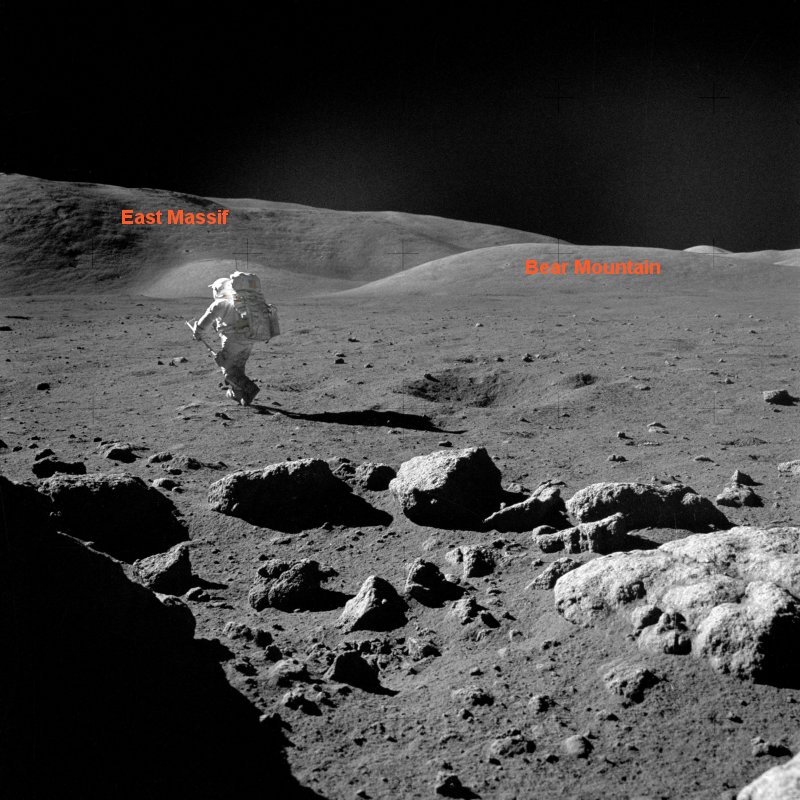
AS17-145-22165 - This picture was taken on EVA 2 at LRV 5, facing South East toward Bear Mountain and the South tip of the East Massif. However, you will notice that the line of sight, as indicated by the red arrow, does not include the LEM. The LEM is too far to the east to be in this picture.
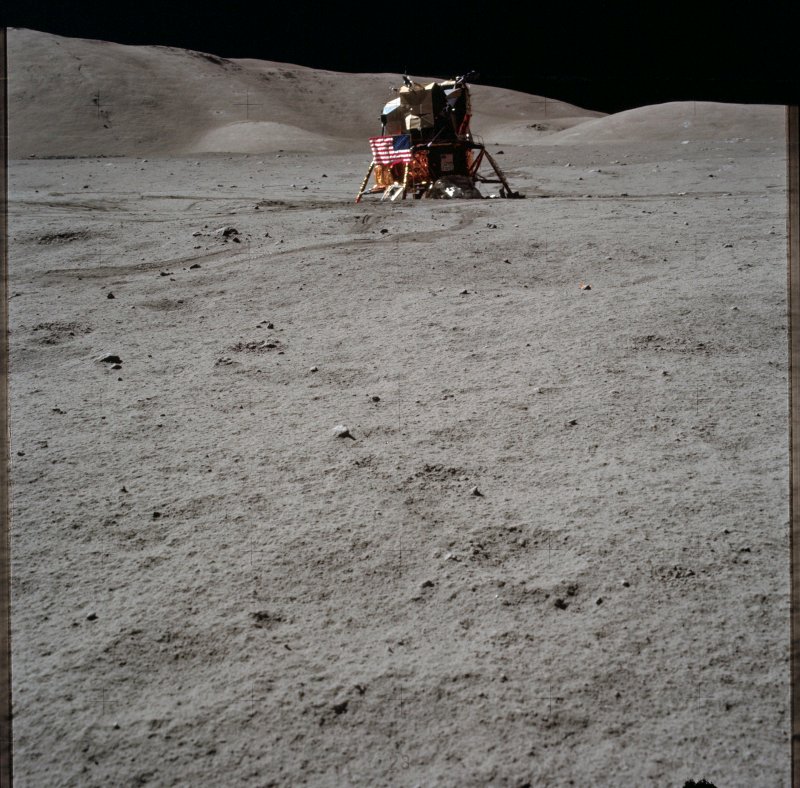
Notice that in this overhead picture the East Massif is not shown, but Bear Mountain is.
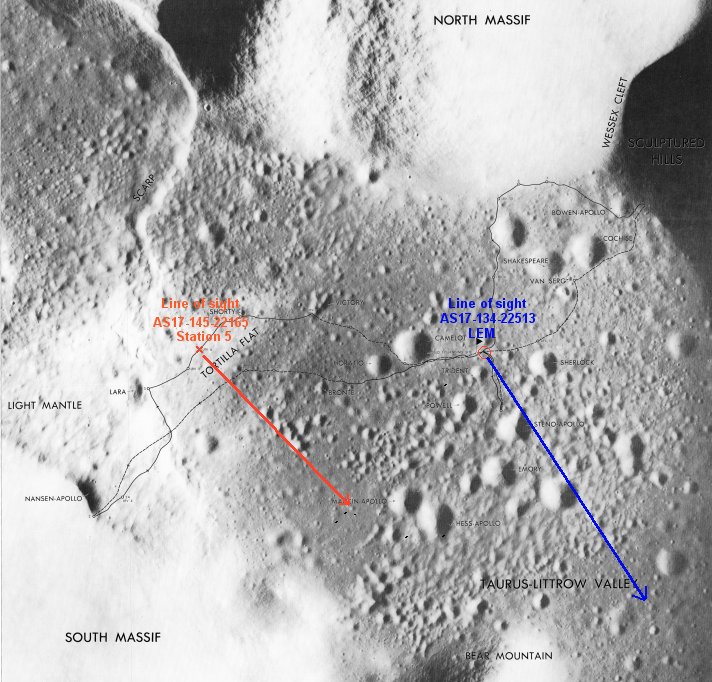
No matter how many times you add the LEM to your illustration, it just does not belong. And as can be seen the parallax affect is very evident in these two pictures. Bear Mountain and the East Massif are seen in both, but there is approximately five kilometers between the two different places these pictures were taken. You should also notice that the foreground in each picture is completely different. AS17-134-20513 has an extreme amount of large ruble where AS17-145-22165 has virtually no ruble at all.
And just to add to the knowledge base for all, Here is a really cool URL that has Apollo Surface Panoramas in a digital library.
"We're gonna turn science fiction into science fact." - Charles Bolden NASA Administrator
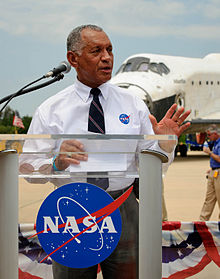
NASA Bio: www.jsc.nasa.gov...
Wikipedia Bio: en.wikipedia.org...

Charles F. Bolden, the 12th administrator of the National Aeronauatics and Space Administration. A member of NASA's astronaut corps from 1980 to 1994 and the first astronaut to speak at a Caltech commencement, Bolden flew aboard the space shuttle four times, logging more than 680 hours in Earth orbit. He piloted the 1990 mission that deployed the Hubble Space Telescope and set a record shuttle altitude of 400 nautical miles. He later commanded both the first Spacelab mission dedicated to NASA’s Mission to Planet Earth (1992) and the historic first joint U.S.–Russian shuttle flight (1994). Source features.caltech.edu...
But if you really want to get a grip on Charles Bolden you have to dig deeper... he was on the mission that deployed the Hubble Space Telescope and for this he deserves all our respect.
"If we continue to destroy the atmoshere we will suffer as a race as a whole. Earth is a lot more resilient then us. If we destroy the atmosphere, then that is it. Life is over" he said. Source emilyevaughn.com...
KeepOut Zone
Some interesting news coming out of the NASA Lunar Science Forum today.
NASA officials are creating the first set of guidelines designed to protect historic sites on the moon, including the Apollo landing areas and the Surveyor landers.
The guidelines are designed to help preserve and protect sites as new rovers begin to explore the lunar surface. Officials said they expect Google Lunar X Prize team competitors to begin landing vehicles beginning in 2013.
Officials want to protect the historical artifacts from dust, debris and damage that visiting rovers might produce. They are also eager to use the capabilities of the rovers to study how the lunar environment has affected vehicles and equipment on the surface.
My notes follow after the break.
Guidelines Cover 3 Categories
Human missions — Apollo (6)
Unmanned landing sites (Surveyor)
Impact/crash sites (Saturn IVB boosters, Ranger spacecraft)
Specifics
Guidelines only focused on U.S. government assets on the moon
Only technical recommendations – no legal requirements
U.S. government legally owns all this flight hardware
A living document – plan to amend as they get more information about the sites and as rover capabilities evolve
Briefed the 28 Google Lunar X Prize teams during the recent team summit in Mountain View — awaiting feedback from the teams
Will incorporate feedback, finalize rules and announce the rules during a future press conference in Washington, DC
Guidelines Cover 3 Areas
Descent and landing
Mobility
Contamination
No-Fly Zones
Heritage Lander Sites (Apollo, Surveyor): no flights within 2 km radial distance
Impact/Crash Sites (Saturn IV-B, Ranger): no flights within 0.5 km radial distance
Each lunar spacecraft should have an onboard reference system to identify the physical location relative to boundaries.
No overflight associated with landing….trajectory should be tangential to the D/L boundary
Designed to protect vehicles from dust being kicked up and possible failures of landers
Landings should be targeted to no less than 2 km away
Puts the lander over the horizon to keep the descent out of the line of sight from the historic site
Deorbit braking stages should be targeted for impact points 2.0 km from landing sites and .5 km from crash/impact sites
No physical contacts with any U.S. lunar hardware
Apollo Sites
Apollo 11 and 17
Recommend that Apollos 11 and 17 are treated as unique with no visits
Apollo 11 – 75 radial meters away from descent stage
Apollo 17 – 225 radial meters away from descent stage
Protects all human activities at those sites
Apollo 12, 14, 15 and 16
Open for scientific investigation
Must stay 1 meter and 3 meters away from objects (depending upon type)
No restrictions on footprints and lunar rover tracks outside of specified areas
Laser ranging retro-reflectors (LRRRs) need to be carefully preserved because they are still being used for experiments today
Crash/Impact Sites
Surveyor – 1 meter buffer zone
Apollo 14 S-IVB – rovers can drive to rim of crater and observe. Entry into crater needs to be coordinated with NASA.
Rovers and Hoppers
Rovers – can drive within designated Apollo sites and around keep-out zones
Can’t stay overnight – if the rover dies, should be outside the exclusion zone
Landers of the hopper configuration are not allowed to land within the 2 km radius
Hoppers can do low altitude tangential flybys of lunar heritage sites. Source www.parabolicarc.com...
reply to post by SayonaraJupiter
Yeah....it's "really, really, really long" because the Sun is "really, really, really" low above the horizon.
Uh Huh......the LM is elevated a bit, on its legs. The elongated shadow is indicative of the actual shape and height of the LM.
You could re-create this on Earth.....build a full scale replica. No, better make it a smaller scale size, because you won't be able to get high enough to match the height of the LRO.
Find a surface with the same topography. Pick the right time of day, to get the angle of Sun above horizon exactly the same. Find a hot air balloon and pilot (or helicopter) to go up and look straight down on your tableau.
Take a picture.
That shadow of the LM descent stage is really, really, really long. It's half way to the crater.
Yeah....it's "really, really, really long" because the Sun is "really, really, really" low above the horizon.
If you look really closely you can see that the shadow is thinner as it gets closer to the descent stage.
Uh Huh......the LM is elevated a bit, on its legs. The elongated shadow is indicative of the actual shape and height of the LM.
You could re-create this on Earth.....build a full scale replica. No, better make it a smaller scale size, because you won't be able to get high enough to match the height of the LRO.
Find a surface with the same topography. Pick the right time of day, to get the angle of Sun above horizon exactly the same. Find a hot air balloon and pilot (or helicopter) to go up and look straight down on your tableau.
Take a picture.
Originally posted by Aloysius the Gaul
reply to post by SayonaraJupiter
I have no problem understanding that NASA didn't provide equipment capable of photographing stars
I wonder why you think it is suspicious tho. It seems likely to me that stars are better photographed using massive telescopes on earth, and photos from Apollo would not add anything new or useful.
Given the strict payload limits for the missions there would need to be good reasons for carrying the equipment.
Also look at the 16mm movie camera footage form Apollo 11, it is kept pointed to the dirt.. In 1965 the spacewalk was recorded with incredible footage available now..
Yet all we have is dirt shots for Apollo 11, why spend all that time composing propaganda shots in a risky environment, when in contrast movie camera footage would have cut the need for so many photos and saved time.. considering the risks of radiation on the moon were unknown, it is surprising they were not cautious on this first landing.
Where are the sweeping moonscape shots? Earth from the surface of the moon etc ? They were only able to fake these shots in the following Apollo missions.. that's why none exist from Apollo 11
Does lunar regolith get burned by the descent engines? How can there be pure black pixels all around the descent stage while the descent stage is
reflecting pure white?
Is the image enhanced? Obviously there is a hand drawn line around the crater so the image is enhanced.
Is the image enhanced? Obviously there is a hand drawn line around the crater so the image is enhanced.
edit on 11/19/2011 by SayonaraJupiter because: (no reason
given)
reply to post by SayonaraJupiter
This has been explained many times. The descent stage is very reflective....that's why it's so bright, in those photos....the Sun is at the zenith, directly above.
The intensity of that light has overwhelmed the white balance of the image in the immediate radius of the bright "hot spot". It is purely a function of camera limitations, based on its design. The LROC is tailored specifically to terrain-map. Catching the images of the Apollo equipment and landing sites is just a bonus.
If you own a video camera, you can see the same effect....might even be able to do it with some digital cameras too. Be sure when you experiment to set it to Black & White, and then experiment by fiddling with the white balance settings, to see the differences.
How can there be pure black pixels all around the descent stage while the descent stage is reflecting pure white?
This has been explained many times. The descent stage is very reflective....that's why it's so bright, in those photos....the Sun is at the zenith, directly above.
The intensity of that light has overwhelmed the white balance of the image in the immediate radius of the bright "hot spot". It is purely a function of camera limitations, based on its design. The LROC is tailored specifically to terrain-map. Catching the images of the Apollo equipment and landing sites is just a bonus.
If you own a video camera, you can see the same effect....might even be able to do it with some digital cameras too. Be sure when you experiment to set it to Black & White, and then experiment by fiddling with the white balance settings, to see the differences.
page 666..... 0.0
sorry I just needed to point that out
sorry I just needed to point that out
edit on 19-11-2011 by targeting because: (no reason given)
Originally posted by Aloysius the Gaul
reply to post by SayonaraJupiter
I have no problem understanding that NASA didn't provide equipment capable of photographing stars
NASA did have the equipment and technology to take pictures of stars if the missions were real.
Look, they even had a tripod!
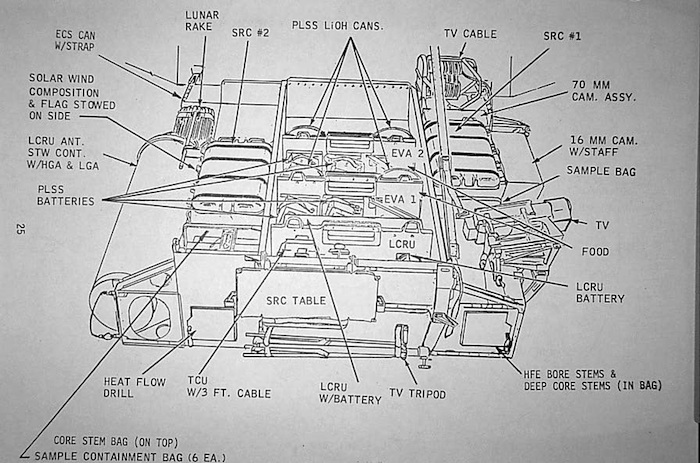
"Well, don't mention it." So that's the way that sort of worked for years. Nobody brought that idea up. A lot of things weren't mentioned and got away with from that standpoint.
And I would like to point out that I used an official NASA source earlier in this thread
www.jsc.nasa.gov...
But that source is no longer available.
404. The requested URL /history/oral.../UnderwoodRW_10-17-00.pdf was not found on this server.
reply to post by FoosM
But, why??
This question keeps being ignored by FoosM and SJ.
Why would pictures of stars be of any worth?? What good would they be? Everyone on Earth already knows what stars look like. The arrangement of the stars is exactly the same, whether you are looking at them from Earth, or from the Moon....Even if you were on Mars, they'd be identical. You have to go some light years away from Earth before any appreciable difference in relative positions are noted. And even then, would not be seen by the naked eye -- would need equipment to measure the tiny differences
So, WHAT is your "point"??
But, why??
NASA did have the equipment and technology to take pictures of stars....
This question keeps being ignored by FoosM and SJ.
Why would pictures of stars be of any worth?? What good would they be? Everyone on Earth already knows what stars look like. The arrangement of the stars is exactly the same, whether you are looking at them from Earth, or from the Moon....Even if you were on Mars, they'd be identical. You have to go some light years away from Earth before any appreciable difference in relative positions are noted. And even then, would not be seen by the naked eye -- would need equipment to measure the tiny differences
So, WHAT is your "point"??
Originally posted by ProudBird
reply to post by SayonaraJupiter
That shadow of the LM descent stage is really, really, really long. It's half way to the crater.
Yeah....it's "really, really, really long" because the Sun is "really, really, really" low above the horizon.
If you look really closely you can see that the shadow is thinner as it gets closer to the descent stage.
Uh Huh......the LM is elevated a bit, on its legs. The elongated shadow is indicative of the actual shape and height of the LM.
The shadow looks like a mushroom, it has a thin base and widens out, the shadow of the LM extends half way to the crater. How far away is the crater?
reply to post by SayonaraJupiter
Go to the Apollo Lunar Surface Journal, using the Google machine, and find the Apollo 11 information there. The site map will have details, and a distance scale to reference.
Shadow shapes are affected, too, by the slant of the terrain. A convex surface that is rising toward the viewer will make the shadow distort to look a bit thinner....a concave depression, will make it look wider.
How far away is the crater?
Go to the Apollo Lunar Surface Journal, using the Google machine, and find the Apollo 11 information there. The site map will have details, and a distance scale to reference.
Shadow shapes are affected, too, by the slant of the terrain. A convex surface that is rising toward the viewer will make the shadow distort to look a bit thinner....a concave depression, will make it look wider.
Originally posted by ProudBird
So, WHAT is your "point"??
WHAT is the point of changing a black velvet sky to blue?
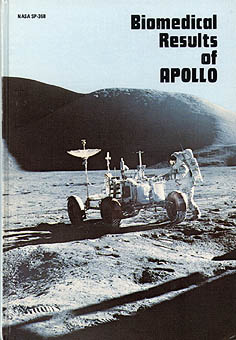
Somebody in this thread already explained that NASA was trying to save on the black ink because it's expensive.
Black was not usually used because it adds another step and raises the cost of printing.
www.abovetopsecret.com...
< seriously, there are not enough
edit on 11/19/2011 by SayonaraJupiter because: (no reason given)
new topics
-
Of course it was DEI
Dissecting Disinformation: 57 seconds ago -
2nd Day Thanksgiving!...(leftovers!!)
General Chit Chat: 1 hours ago
top topics
-
New Disney Star Wars Films Failing Test of Time?
Movies: 13 hours ago, 5 flags -
2nd Day Thanksgiving!...(leftovers!!)
General Chit Chat: 1 hours ago, 2 flags -
Of course it was DEI
Dissecting Disinformation: 57 seconds ago, 0 flags
active topics
-
Of course it was DEI
Dissecting Disinformation • 0 • : fringeofthefringe -
New Disney Star Wars Films Failing Test of Time?
Movies • 17 • : TzarChasm -
2nd Day Thanksgiving!...(leftovers!!)
General Chit Chat • 4 • : nugget1 -
Unidentified Flying Objects Over U.S. Military Bases in Northeast UK, as of roughly 11 a.m. CST.
Aliens and UFOs • 32 • : Kangawoo2 -
The Party of Peace - Trump Cabinet Picks Targeted with Death Threats
US Political Madness • 51 • : RazorV66 -
-@TH3WH17ERABB17- -Q- ---TIME TO SHOW THE WORLD--- -Part- --44--
Dissecting Disinformation • 3416 • : duncanagain -
Results of the use of the Oreshnik missile system in Dnepropetrovsk
World War Three • 263 • : DontTreadOnMe -
Anyone like the Scorpions?
Music • 23 • : Flyingclaydisk -
The Cost of True Discipleship—Count the Cost
Religion, Faith, And Theology • 5 • : alwaysbeenhere2 -
Mass UAP events. DC. Machester Airport, UFOs over sub base in CT, Nuke bases.
Aliens and UFOs • 24 • : devilhunter69

